 |
Agate4u.com (Agate for You)
What is Jasper?
Ok, so we have looked at Agate, and when we did so I said that Agate was a type of Chalcedony which is a type of cryptocrystalline Quartz.
Cryptocrystalline Quartz is so named because the individual crystals are too small to be easily distinguishable under a normal microscope. Quartz itself is separated into two groups based on the size of the individual grains or crystals. There is macrocrystalline Quartz which means that the individual crystals are distinguishable with the naked eye, and cryptocrystalline quartz which means that they are not.
Chalcedony is a form of cryptocrystalline quartz, and so is Jasper.
How then do they differ?
Rocks and minerals which are made up of Cryptocrystalline Quartz are separated into two types; fibrous and microgranular.
Agate is one of the fibrous cryptocrystalline varieties. Jasper is one of the granular varieties. In practical terms this makes Jasper a more coarse specimen. Both, being so closely related have the tendency to look and feel greasy, but in practical terms of viewing the difference between the two, agate looks more like greasy coloured glass, Japer looks more like a greasy coloured stone, but to be honest, depending on the variety of jasper, it can take an enormously fine and beautiful polish which often makes it look like glass, but it is never transparent.
The guide rule of thumb is - hold a thin slice of agate up to the light or place a strong light source behind it and you will see some light come through it no matter how translucent it is. Hold a piece of Jasper up to the light and you will see no light come through.
It is still classed as a variety of Chalcedony, but an opaque variety. It is nevertheless very often a beautiful stone. Indeed, I am somewhat of a Jasper fan. The varieties are endless, the colours and styles are vast, and in all honesty I could devote a whole book to Jasper.
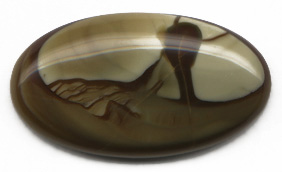 |
Here is a nice example of a type of Jasper which is called Biggs Picture Jasper, so named because it was discovered while constructing Interstate 84 through Sherman County. Near Biggs, Oregon in the USA. The find is now covered by the Road. |
| As far as finding Jasper in the UK is concerned there is quite a lot of it. It can be picked up in the form of pebbles off the beach in quite a number of parts of the country, and there are some quarries which extract the rock. A typical example of British quarried jasper is shown here. Note the rocks natural waxy greasiness. |
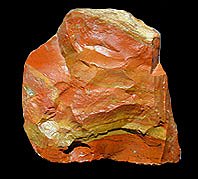 |
The colours of Jasper are, as I said before - vast. Brown, orange, purple, red, green, yellow, and a whole variety of mixed shades, bands and patterns are often present. The colour usually depends on which other mineral was mixed in and present during its formation.
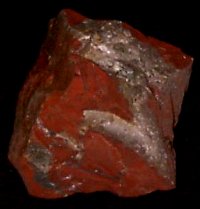 |
Here is a lump of rough UK Jasper which is a deep blood red colour. Many examples of Jasper have Quartz veins running through them which makes them an attractive proposition to the artisan stone polisher to make a feature of this fact. |
| Here is a heart shaped pendant which has been cut and polished out of a piece of blood red jasper making a use of the Quartz vein in a very attractive manner. |
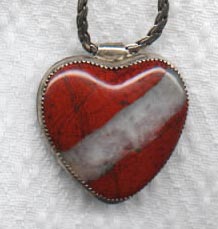 |
So you are walking along a beach and pick up a pebble. Is it Agate, is it Jasper? Is there a simple rule of thumb to quickly tell?
Yes, as a rule of thumb - dry the pebble and make sure that it is perfectly dry. Now, when it has dried does it look and feel waxy. If it looks and feels waxy then the chances are high that it is a Chalcedony of some description so it is Agate or one of its associate family or the other main member of the Chalcedony family - Jasper. This rule of thumb however only goes for pebbles on a reasonably active surf beach where the action of the surf has had a chance to semi grind / polish the pebble. Rough Jasper from a quarry does not always display this feature.
Just like we give different names to Agate, i.e. Fortification Agate, Banded Agate, and so on to describe the structure or pattern of the rock, so we give different names to identify the different structure and patterns of Jasper so that we can classify them.
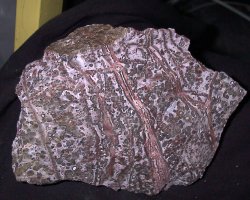 |
This is a piece of rock which is called Leopard Skin Jasper. It is so called because of the leopard skin pattern which it displays. This particular chunk has some beautiful veins of pink Jasper running through it and some Pyrite, but this cannot be seen from this picture. |
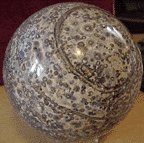 |
Here is a sphere which has been cut and polished out of a piece of Leopard Skin Jasper. In this case the rock was not as pink as the example shown above, but the same structure can clearly be seen. |
I once read a comment that somebody made regarding the statements in the Bible which record Jasper as a semi-precious stone, and they said "The Bible writers must of course have been talking about something quite different to what we know as Jasper, because there is nothing semi-precious or nice about the stuff that we know as Jasper today.
I don't know what examples of Jasper this person had seen, but it is indeed a beautiful stone very often with some treasured patterns and colours.
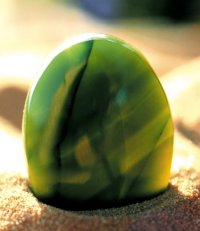 |
Here is a cabochon which has been cut and polished out of a piece of green Jasper ready for mounting into a necklace or a brooch. The colours and texture are magnificent. |
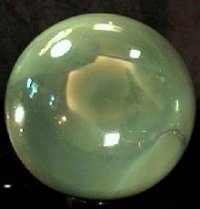 |
And here is a sphere which has been cut and polished out of a lighter more sage green Jasper, but again the colours and texture are quite beautiful. |
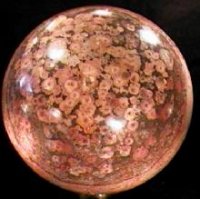 |
A sphere which has been cut and polished out of a piece of Poppy Jasper, so named because it looks like a bunch of pink poppies. This example was ground from rough rock from Mexico. |
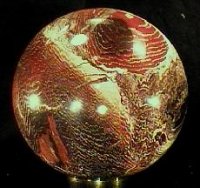 |
A Flame Jasper sphere ground out of a piece of rough rock from Australia. This display some of the most gorgeous and superb figuring and layered structure quite unlike anything else. There is not a rock in the world that can imitate it. |
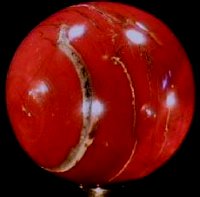 |
Brilliant Red Jasper cut and polished out of a piece of Welsh Jasper. Rock from North Wales, UK. |
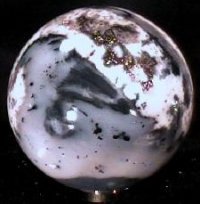 |
Milk and blue grey Jasper cut and polished out of a piece of rough rock from North Wales UK.. |
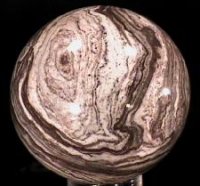 |
Chocolate and pink swirls Sphere from a piece of rock from North Wales, UK |
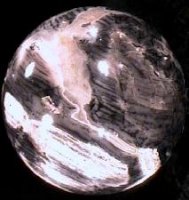 |
A lovely Jasper sphere displaying a whole host of grays, pinks and silver, cut and polished from a piece of rough rock from Cumbria, UK. |
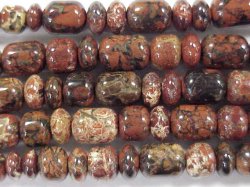 |
A range of brecciated jasper barrels displaying a multitude of colours and patterns. |
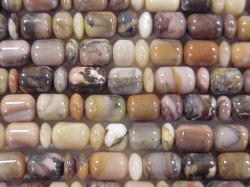 |
Another range of Jasper barrels displaying a multitude of colours and patterns. |
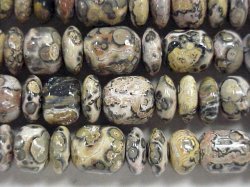 |
And another range of Jasper barrels displaying a multitude of colours and patterns of the Leopard Skin variety. |
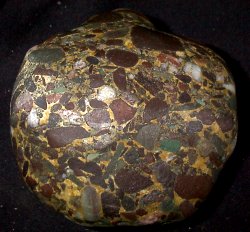 |
And here is a lump of brecciated rough Jasper that will be sphered when I get around to it. This is perfectly natural, not man made. It is a conglomerate of all different coloured Jaspers. This lump is from North Wales, UK. |
Jasper, like Agate, is a most staggering rock when it comes down to natural beauty. Diamonds may well be a girl's best friend, but only because they are so highly rated and valued in pure monetary terms. A goodly cut diamond does display a fire, but as far as beauty and being pleasing to the eye is concerned both Agate and Jasper win hands down in my opinion. There is no contest.
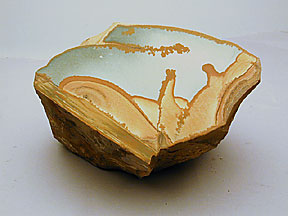 |
Here is a piece of Biggs type Jasper, perfectly natural just as Mother nature created it. Silver grey, surrounded by shades of brown, almost looking like a mandalbrot set of fractal geometry. |
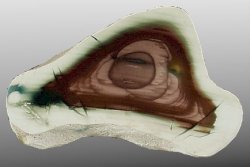 |
And here is a piece Imperial Jasper which has been slab cut. |
| And another piece of Imperial Jasper which is verging on Agate in style.. |
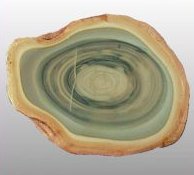 |
So, Jasper is a form of microgranular crystalline Quartz and a member of the Chalcedony family. It tends to look and feel greasy, and is always opaque, i.e. you cannot see light through it. It comes in a massive range of colours, styles, patterns and structures. It polishes beautifully because it, like Agate is hard.
|
 |



